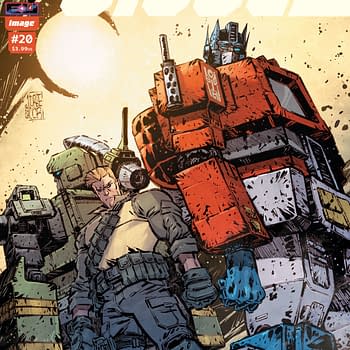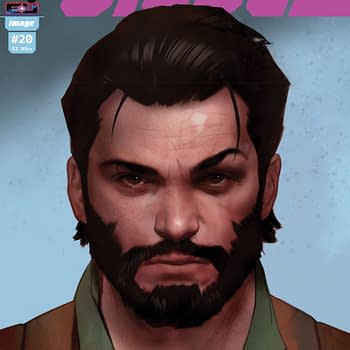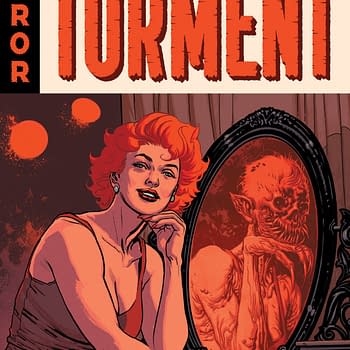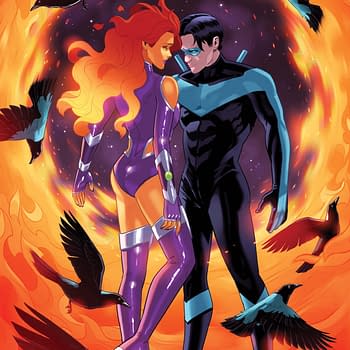Posted in: Comics, Recent Updates | Tagged: becky cloonan, boom studios, Brendan Fletcher, Brennan Lee Mulligan, captain america, Comics, Dave McCaig, dc comics, entertainment, Esad Ribic, Fiction Squad, gotham academy, jason aaron, Karl Kerschl, Marvel Comics, Molly Ostertag, paul jenkins, Ramon Bachs, rick remender, ron garney, Russell Dauterman, simon bisley, Strong Female Protagonist, top shelf
Thor's Comic Review Column – Gotham Academy, Captain America, Fiction Squad, Strong Female Protagonist, Thor
This Week's Reviews:
Gotham Academy #1
Captain America #25
Fiction Squad #1
Strong Female Protagonist
Thor #1
Gotham Academy #1 (DC Comics, $2.99)
By Devon Sanders
Here is something I haven't said about a DC comic in nearly three years, "Wow! What an absolutely charming little book. Can't wait for the next issue!"
Gotham Academy is a quick-witted, beautifully drawn comic that reminds of the days when DC Comics would try new and exciting things such as Gotham Central.
Gotham Academy #1, much like Central, takes advantage of one of Batman's greatest story engines, Gotham City.
Gotham Academy is full of rich characters with dark tales to tell and none more so than GA's main protagonist Olive Silverlock, a young lady with secrets galore and a penchant for rising to the occasion whenever there's trouble. Joining her in the Academy is young "Maps" Mizoguchi, a newcomer to Gotham Academy, given to wild-eyed speculation and the finding of trouble. Add those two things together while being the sibling of Olive's ex, Kyle and you have the perfect recipe for what could be DC's greatest hero duo since Blue Beetle and Booster Gold.
Writers Becky Cloonan and Brendan Fletcher pull this all together masterfully with thoughtful dialogue and whip-crack pacing. The danger in writing teens, too often, is in trying them to make them sound… well, like teens. Cloonan and Fletcher avoid this by simply providing the characters with words that honor the characters and readers' collective intellects. It's done to great effect as I simply can't wait to find out more about this young cast and the supporting staff of Gotham Academy.
In a book that already shines as bright as anything I've seen from DC in years, perhaps the brightest candle is artist Karl Kerschl. Kerschl understands that people use their whole bodies to convey emotions; he uses this to fulfill the needs of the script, perfectly giving the characters life within a two dimensional plane. I'd be incredibly remiss if I didn't mention this another of this comics' MVP's, the colors of Geyser with Dave McCaig. Their Gotham is full of lush greens and blues and at times, seems to be a city afire. Somehow, in all of this they manage to give one the feeling of somehow reading an animated movie.
Gotham Academy #1 with its lively mix of characters and creators, to paraphrase Commissioner James Gordon is very much, "The hero Gotham deserves and very much the one it needs."
Devon Sanders, the writer of this review's greatest claim to fame is that Astro City writer Kurt Busiek once wrote him into an issue of Action Comics. Since the formation of the DC's New 52, he hasn't been seen since. This makes him sad as he feels he'd make a great sidekick to Lois Lane.
Captain America #25 (Marvel, $4.99)
By Cat Taylor
Yes, that's seriously the cover of the "final" issue of Captain America before it gets rebooted again. I really don't get why they chose that cover image given that there hasn't been any attempt to keep the identity of the new Captain America secret. Rick Remender even pokes a little meta-fun at the anticlimactic reveal in the story by having the announcement made in a roomful of past and present Avengers with Sam Wilson saying, "you guys all knew it was me, didn't you? There's literally no drama in this reveal." For his part, Remender seems very aware of the publicity and criticism of the Falcon becoming the new Captain America. For instance, he addresses one of the main concerns regarding Sam Wilson in the role by having one of the villains echo some fan criticism by saying that Wilson doesn't possess the experience necessary for the role. Admittedly, it's a concern that I also have regarding this move.
Sure, the Falcon has been around a long time, but he has never been portrayed as one of Marvel's major heroes or top hand-to-hand combatants, nor does he have any superpowers to make up for his comparatively lower level fighting skills. In past appearances, he has simply been a guy with wings who has been a C-level hero at best. Remender further echoes these concerns by getting way meta and cheesily heavy-handed through the voice of the villain again saying, "Sam Wilson is not up to the task. Steve Rogers is a soldier, a warrior. This man is a community organizer." See what he did there? Huh? Do you get it? Should I explain it to you?
It is true that if one really looks at the situation objectively, a character like Paladin would be a more effective combatant in the role. On the other hand, Paladin is a mercenary for hire. So, while he may be a more effective fighter, he lacks the "heart" and "integrity" necessary to be Captain America. The beginning of this story works very hard to remind the reader that the Falcon does possess these characteristics, but it would have been a more effective sell to spend several issues elevating the Falcon's status and reminding us of his "spirit" rather than a hard push in the first few panels of this issue.
Regardless, seeing the Falcon in the Captain America role is going to be a pretty hard sell. Certainly, the early issues will sell well due to curiosity and a large contingent of people wanting to support more minority heroes in larger roles, but after the hype has died I wonder if the upcoming series will last past twelve issues. Of course, a good writer can make all the difference in the world, and Remender has established a reputation as a fan-favorite during his stints on Captain America. Despite all that, based on past portrayals of the Falcon, it's going to come off as a cheat if he's suddenly kicking ass at an equal or near equal level to Steve Rogers and other A-list heroes. How Remender handles Wilson's use of the shield should also be particularly interesting.
After all, it's not a boomerang but Rogers had acquired the ability to use it like one. Will Wilson naturally adapt to that skill or will he have to use it more like a shield is intended? Speaking of acquired skills with special equipment, at least Wilson still has his wings. I know they don't really fit the Captain America image, but it wouldn't have made much sense for Wilson to throw away what's always been his most effective tool. Although I admit that it took seeing his use of the wings in the movie Captain America: Winter Soldier to make me see how cool they can be. However, that also leads to another question. Why does this Captain America get a brand new costume that looks barely like the original? If you're going to be Captain America, be Captain America. If you want to keep being the Falcon, then be the Falcon. As it is, Sam Wilson looks like he should be calling himself American Eagle.
With all those "elephant in the room" thoughts out of the way, there is still the question of how is the "final" issue of this volume of Captain America series as a story? As I said earlier, a good writer can do amazing things with a character. However, if I had nothing to go on other than this story, I wouldn't be excited about the upcoming series at all. I know Remender has written some lauded Captain America stories, but he seems to be simply fulfilling a contractual obligation with this issue. The story, such as it is, starts with a rush to wrap up the recent arc with Arnim Zola from an alternate dimension trying to destroy our Earth-616. As part of this plotline, a resolution involving Zola's daughter, Jet Black, felt extremely forced and rushed. Not only that, but it required superhumanly fast and powerful characters like Iron Man and Thor to appear dumb and frozen with no explanation for their lack of effectiveness at a simple task.
Secondly, the "big reveal" that makes up the second half of this story is drug out beyond necessity in direct opposition to the rush job in the first half. This "drug out" reveal is made even more painful by portraying all of the gathered Avengers as a bunch of characters who are trying desperately to be funny and failing miserably. Everyone from Spider-Man to Steve Rogers to Vision and Thor are acting exactly the same and telling the same level of dumb jokes. Any of the characters could be interchangeable at this point and the whole experience came off as a terrible episode of a bad sit-com. The only saving grace to this issue at all was the epilogue that revealed a secret Hydra inner circle and a mystery that should help to create interest for readers who may have been planning not to pick up the rebooted series next month. Even the art improves in the epilogue, as it appears the extremely large art team (two pencilers, three inkers, and three colorists) knew what was really important in this issue.
Beyond the problems I had with this story in particular, I have an overarching concern with too many mega-cross title events happening around the same time. In this same month, over in Avengers and New Avengers, Steve Rogers isn't on good terms with Iron Man. Yet, they're hanging out and yukking it up over here. Meanwhile, Thor just lost Mjolnir over in Original Sin, but he's walking around with it in this issue. Perhaps I'm mistaken but I'm pretty sure he lost that hammer while Steve Rogers was still a young man. Yet here, Rogers has aged and Thor still has his hammer. It's all very confusing.
On the whole, this issue is purely a set up for the new series and therefore impossible to discuss without a lot of speculation about what is to come. As such, this issue was a pretty anticlimactic finale. It's a shame that Marvel doesn't feel confident enough to just keep the series going with Wilson in the Captain America role without rebooting the series with a new first issue. Of course, we know Steve Rogers will be back in the role before too long and Sam Wilson will enter the ranks of "other" Captain Americas. So, at the end of the Wilson run, we'll see how his tenure stacks up.
Cat Taylor has been reading comics since the 1970s. Some of his favorite writers are Alan Moore, Neil Gaiman, Peter Bagge, and Kurt Busiek. Prior to writing about comics, Taylor performed in punk rock bands and on the outlaw professional wrestling circuit. During that time he also wrote for music and pro wrestling fanzines. In addition to writing about comics, Taylor tries to be funny by writing fast food fish sandwich reviews for Brophisticate.com. He's also glad to be back from the Nashville Comic Con and adding his two cents to Thor's Comic Column again. You can e-mail him at cizattaylor@hotmail.com.
Fiction Squad #1 (Boom! Studios)
By Bart Bishop
I'm fed up with fairy tales. With Fables and Once Upon a Time, and the upcoming movie adaptation of the Broadway show Into the Woods, having dragged the bottom of this mode of storytelling for everything it's got, I approach Fiction Squad #1 with hesitation. What more can be said about children's tales through the eyes of an adult? Of course these parables and narrative lessons fall apart under close scrutiny; they're not meant to be engaged with in any critical capacity. Still, Paul Jenkins is a writer I've enjoyed for a long time, starting with his runs on The Incredible Hulk and Peter Parker: Spider-Man, so it doesn't hurt to give the benefit of the doubt. Ramon Bachs, meanwhile, has a fun and flexible style that would seem to be fitting for this type of comic. The end result is something that has been done before but is done well here, but what's most appreciated is how it doesn't go intentionally raunchy for shock value but instead flirts with and flips classic mature tropes.
Fiction Squad is actually a spin-off of Jenkins's earlier Fairy Quest, itself a Kickstarter project that resulted from Jenkins leaving DC and Marvel to exclusively work for Boom! Studios. Set in the land of Fablewood, "far across an unknown ocean, a million miles from where you are now," a kind of Jungian collective unconsciousness where all stories, those that have been and will be told, exist in parallel. Although there are many lands, Children's Stories is by far the largest, with the Village of Rimes being the locale for this particular tale. The ball gets rolling when Humpty Dumpty falls off a wall, but the twist is that he's pushed! This brings into sharp focus that fact that "every nursery rhyme is a crime scene," and thus the police arrive to investigate. Enter Frankie Mack, a hard-nosed detective from the Crime Realm that is every noir detective ever put to print. He knows there's a gang war brewing between the Queens and the Witches in town, and Humpty Dumpty is just the latest in a series of violent shots across the bow between the two factions.
Jenkins is obviously having a good time here, and that enthusiasm shows. It's an easy habit to fall into, playing in the sandbox that is children's stories, but he's doing a bit more than just making references here. We're all familiar with these stories from oral passing down to picture books to Disney films and the modern reinterpretations, so there's no time spent on spelling anything out, at least once the plot gets going. Most characters are signified by name and design alone, so there's never any pause to wink at the audience. It helps that Frankie Mack is an outsider from a diametrically opposed form of storytelling, so his attitude makes for a fun contrast against the bright, broad archetypes surrounding him. The problem is the plot takes a bit too long to get going, with several pages of exposition spent on establishing the Village of Rimes and even more pages devoted to Humpty Dumpty's crime scene before Frankie comes in with a narration establishing himself as the protagonist. It's very stilted and disjointed. I do, however, appreciate Jenkins's restraint when it comes to audience expectations. He could easily dirty things up, but instead ironically plays against the adult audience by having Humpty Dumpty survive his fall and Frankie sucking a lollipop instead of smoking cigarettes.
Ramon Bachs makes for a good fit with Jenkins considering the material, but does make a few questionable choices. He has a style very much influenced by the Manga influx into the United States of the 1990s, very much along the lines of Humberto Ramos who penciled Fairy Quest, and the likes of Chris Bachalo and Joe Madureira whom all made big splashes at Marvel. Bachs's style is appropriately cartoony for the text, but he depicts the many maidens as nothing but buxom blondes. Take Humpty Dumpty's wife: sure, Jenkins is going for a Jessica Rabbit thing, with a beautiful woman married to a schlub, but why Daisy, Frankie's would-be girlfriend? Noir typically utilizes the "nice girl" trope to contrast against the femme fatales(s), but Daisy falls out of her shirt as easily as Alice (from you know where), who should at least come across as in-your-face considering she's the leader of a gang. It just feels a bit too wet dreamy for my tastes, with three juvenile depictions straight off of Tumblr.
For the most part Jenkins avoids that kind of indulgence, instead choosing to riff on popular folk lore in a nicely iconoclastic way. Bachs is also fun and ribald with the right amount of restraint throughout most of this issue, but needs to practice new models for his female characters.
Editor and teacher by day, comic book enthusiast by night, Bart has a background in journalism and is not afraid to use it. His first loves were movies and comic books, and although he grew up a Marvel Zombie he's been known to read another company or two. Married and with a kid on the way, he sure hopes this whole writing thing makes him independently wealthy someday. Bart can be reached at bishop@mcwoodpub.com.
By Graig Kent
It's like my grandparents adapting to the VCR (the what now?). That's how I feel about web comics. I don't have any objection to them, in fact I quite like the idea of what they can do and what they represent, especially for creators, but I just have the hardest time turning to technology for my sequential art entertainment. As such, I all too often forget to explore web comics, and even when I do, I forget to go back to the ones I enjoy. My habit still sees me in brick and mortar stores every week, picking up something physical, a pile of physical in fact (the "to sort" stack beside the bed is over a hundred comics deep in only a few months). I recognize that I'm getting old(er), in part because I've been so slow to adopt webcomics into my regular life, when I'm sure that someone 15 or 20 years my junior has these type of things spoon fed to them on a daily basis through some sort of feed, consuming new pages of dozens of titles on the reg in a very rapid manner.
The problem I have with many webcomics — talking less about those that are humour strips and more about the serialized ones — is they can feel very unfulfilling or disjointed in their component parts. In a brick-and-mortar example, I point to something like the weekly Futures End series at DC where, week-to-week, a single issue really doesn't satisfy, but as a part of the whole it tells a great big story. Same with Jonathan Hickman's Avengers, where even a single trade paperback feels incomplete as it's just a small section of the grander portrait he's painting. Whittle that all down to one page every day or every other day or once a week or longer and it can be a genuinely tedious or unsatisfying process to consume a webcomic as it happens. It's in no way a testament to the overall quality of storytelling, it's just that sometimes the message can get lost in the delivery.
I'm feeling that way with Strong Female Protagonist, a tremendous webcomic that I just discovered a couple weeks ago. I binge read the output to date (about 250-ish pages spread over five issues) and adored it, but I just jumped back today to see only three new pages added, and it wasn't enough. Furthermore, I found that I had lost my place, my understanding of where the series was and what the thrust of the story at hand is. But, with web comics, particularly if their site is designed well enough (as this one is) it's easy enough to jump back and thumb through pages to quickly brush up.
The webcomic is the product of writer Brennan Lee Mulligan and artist Molly Ostertag, and it left the gate 2 years ago with a very clear definition of what it wanted to be: a superhero series that addressed real-world issues at the most personal level. A book like this could have turned out so incredibly preachy but it refrains from taking the pulpit and acknowledges that it doesn't have the answers any more than anyone does.
The titular character, the strong female protagonist, is Alison Green, one of many who developed superpowers spontaneously around the age of 15 a number of years prior. Upon meeting other teens of her ilk she agreed to form a superhero club and actually wound up putting her super-strength, flight and invulnerability to use as Mega-Girl. But in a fit of frustration and self-doubt a few years in, she retired from her public life, exposing her identity on national television, and going to college instead, much to the chagrin of some of her friends (and prejudiced teachers and classmates). I liken it to a child star (say Natalie Portman or Joseph Gordon Levitt), having achieved some fame and acclaim, but leaving public life and going back to school, trying to be normal and fit in with paparazzi hounding them (substitute supervillains for paparazzi and you get the subtle shift)..
The series starts off, as one could expect from new storytellers, rather clunkily. There are various awkward shows of Allison's powers, and her everyday life is a bit too cluttered with the book's mandate to be socially aware (an Occupy movement rally, various protest paraphernalia in her dorm). The first chapter really comes to life, though, when Alison has a rather frank conversation with her doctor about her sex life, and lack thereof. It shows a self-awareness to Alison that we don't see in most, if any, other superhero comics. When Alison is asked if she's afraid she might lose control in an intimate moment, she lowers her gaze and blushes. It's one of the most truthful moments I've read in a comic, web or otherwise.
This series lives in its frank conversations. Alison has left a life behind, but it's a life that keeps trying to catch up to her. She has these enjoyably light moments with her ex-colleagues and family, these tense moments with friends and teachers, these sweet and sour moments with the public, and destructively cathartic and alternately compassionate moments with her enemies. Yes, some conversations lead to conflict, most don't.
Through all this Alison comes to the realization that her superhero-ing was a bandaid solution to a gaping wound of world problems. It did help in a small way, as saving the world a few times might, but her inability to reconcile the fact that she can't affect the bigger problems with the world is what drove her from the life. Now, through education, she's seeking some form of enlightenment, a journey through knowledge and self-discovery to see if there are truly answers to the problems of the world, and whether she can actually make a difference any other way. Everyone else has their opinions, but she's got to live her life and learn for herself.
The series, throughout, paints not just Alison, but every character, as part of a natural world, breaking ever-so-slightly when the more fantastic superhero elements seep in. But even when Mulligan paints his story with a broader stroke, he eventually reveals the depth beneath. Whether it's a bigoted professor or a cliched envious sister, they don't stay so cookie cutter for long.
The series does tackle issues, but not in a Blossom kind of way where it's made out to be "a very special issue". The topics are dealt with as part of Alison's life, not as random introductions. They're viable things she would think about and face as both a layperson and an ex-superhero. The current storyline, still ongoing, deals with rape culture in young America, and it's told with all the uncomfortableness, anger and sympathy it should entail. It's not an easy topic to approach, and it's not dealt with lightly, but it is dealt with smartly. Mulligan deals with it both as an unfortunate aspect of college life (Alison watches a drunk girl's back, despite the protest of innocence from the people around her), and in a "revenge-fantasy" thread (as one of Alison's ex-teammates is out killing bad people who roam free), and it's really quite deftly executed.
Much credit goes to Mulligan for drafting one of those "superheroes in the real world" scenarios we see so very often, and doing it as well, if not better than any of them. Astro City has long been a benchmark for this type of storytelling, and Strong Female Protagonist, even moreso, gets at the heart and into the head of down-to-earth superheroes, their potential impact, and all the other bits that surround it.
Mulligan could likely write a good novel with this material, but that would deny us Ostertag's wonderful visualization of Alison's world and the people who live in it. Ostertag has grown immensely and incredibly as an artist in the two hundred-plus pages she's illustrated so far. Her action may still be stiff and awkward at times, and her level of detail somewhat sparse, but she has mastered the art of visualizing conversations, the bread and butter of the series. I delight in her figures' gestures as they speak, their facial expressions and unconscious reactions that are so well realized the conversation wouldn't read remotely the same without them. Ostertag's style reminds me of three different (yet similar) Brian's: Lee O'Malley (Scott Pilgrim), Hurtt (The Sixth Gun) and Churilla (Big Trouble In Little China), which is fine company indeed.
If I'm in any way frustrated with Strong Female Protagonist, it's only in my desire for more, and more in concentrated doses. It's beautiful, laugh-out-loud funny, painful, uplifting, heart wrenching, exciting, and, as times, upsetting. It's really quite great at everything. If you, like me, prefer your comics on paper, and laying down cold hard cash for them, then watch the website's shop for the printed version, or distributed through Top Shelf to your brick-and-mortar in December. It's certainly worth it, whether it's your time, your money, or both.
Graig Kent really does have big piles of comics beside the bed that need to be sorted and filed this weekend. He's written some new movie reviews at wedisagree.blogspot.com, no new tweets at @thee_geekent, and posted some new corgi photos at tacomblur.tumblr.com.
Thor #1 (Marvel, $3.99)
By Jeb D.

In the letter column, Aaron assures readers that bringing us a female Thor was not (or at least not "just") a publicity stunt, and that it plays into his larger thematic concerns. But if the publicity stunt angle is inescapable, it's going to sit uncomfortably with the expectations for those whose curiosity was piqued by USA Today: Aaron's not here to let the curious pick up one issue, discover the secret, and move on; anyone who wants to learn just what's up with the new distaff version of the thunder god is going to have to do a bit of reading first, while Aaron continues to build his ongoing epic.
If Thor represents the high point of Aaron's Marvel tenure (well, that and his brief, mad Ghost Rider), Original Sin was clearly its nadir: a muddled shrug of an "event" whose unfortunate ripples will be felt in various corners of the Marvel U for a while, and which represents the weakest aspect of this relaunched Thor. Thor can't pick up Mjolnir because he's no longer "worthy", but as a result of a lame bit of "tell-not-show": it's all down to whatever Nick Fury whispered to him on the moon (as one does). And that's a shame, as the general idea of the hammer identifying its "worthy" owner (the phrase engraved on Mjolnir changes to read "…if she be worthy…" once it's picked up) fits nicely into Aaron's run; it's just too bad he had to muck that bit of the storytelling up by dragging it in from Original Sin.
So what Aaron offers here is just the opening gambit of a long game: he knows that the book's been sold on the secret of new Thor's identity, but he's treating that as just another element in the mix. Villainy still comes from the Roxxon corporation, and a Malekith far more interesting than the one Christopher Eccleston provided. He packs the issue so full with incident that the power-play dialog sections between Odin and Freya are given plenty of depth without shorting the action, from frost-giant invasion to Thor's desperate wielding of a battle axe in Mjolnir's place… while riding underwater on a goat.
Artist Russell Dauterman (Nightwing, Supurbia, and costume illustrator for such films as Captain America: The First Avenger) certainly has some big shoes to fill (Esad Ribic pretty much defines modern epic Asgardian storytelling, but Aaron's Thor has also featured outstanding work from Ron Garney and Simon Bisley, among others). Considering that this book is on a much larger scale than what we've seen from him before, it's impressive how quickly he takes it in hand: giants and gods, sharks and submarines, lunar landscapes and battle goats—none of which takes away from the character work that brings Odin and Freya, in particular, to convincing life.
No one who's been reading Aaron's Thor: God of Thunder needs any convincing to continue with the renumbered version; the only thing "new" is the marketing: in the context of what Aaron's done so far, the idea of a female Thor rather complements the other aspects of the character he's presented. For those who just want to know "Who is she?", go ahead and jump on here: it may be a while before you get your answer, but it'll be worth the wait.
Jeb D. is a boring old married guy whose comics background includes attending the very first San Diego Comic-Con, being lectured on Doc Savage by Jim Steranko, and fetching an ashtray for Jack Kirby. After a quarter-century in the music biz, he pursues more sedate activities these days, and will certainly have a blog or Facebook account or some such thing one day.



















